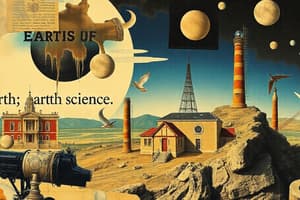Podcast
Questions and Answers
What is the significance of studying Earth Science?
What is the significance of studying Earth Science?
It helps people, serves as a tool for assistance, and aligns with the Creation Mandate from Genesis 1:26-28.
Earth Science should glorify God and declare His glory.
Earth Science should glorify God and declare His glory.
True (A)
Which of the following are fields of Earth Science? (Select all that apply)
Which of the following are fields of Earth Science? (Select all that apply)
- Meteorology (correct)
- Astronomy (correct)
- Geology (correct)
- Psychology
What are the two primary motions of the Earth?
What are the two primary motions of the Earth?
The variable that is changed or controlled in an experiment is called the ______ variable.
The variable that is changed or controlled in an experiment is called the ______ variable.
Which of the following statements about planets is true? (Select all that apply)
Which of the following statements about planets is true? (Select all that apply)
Name one characteristic that distinguishes terrestrial planets from Jovian planets.
Name one characteristic that distinguishes terrestrial planets from Jovian planets.
Which of the following have significantly smaller sizes than planets and primarily orbit between Mars and Jupiter?
Which of the following have significantly smaller sizes than planets and primarily orbit between Mars and Jupiter?
Mercury is the ______ planet to the Sun.
Mercury is the ______ planet to the Sun.
Flashcards are hidden until you start studying
Study Notes
Introduction to Earth Science
- Earth Science is important for understanding the world around us.
- It can be used to help people and serve as a tool for assistance.
- Earth Science aligns with the Creation Mandate from Genesis 1:26-28, which calls us to love our neighbor and be responsible stewards of God's creation.
- Studying Earth Science should glorify God and declare His glory.
Approaches to Earth Science
- Christians should view Earth Science through the lens of their worldview, which influences their scientific understanding.
- Models and theories in Earth Science should be compatible with biblical teachings.
The Scientific Method
- Ask a question based on observations.
- Research existing knowledge related to the question.
- Formulate a testable hypothesis.
- Design an experiment to test the hypothesis.
- Collect and analyze data.
- Draw a conclusion about the validity of the hypothesis.
- Report the findings.
Types of Science
- Operational Science: Focuses on understanding current phenomena using scientific methods.
- Historical Science: Investigates past events using principles like uniformity and cause-and-effect.
Fields of Earth Science
- Geology: Study of the Earth's composition, structure, and processes.
- Petrology: Study of rocks and their formation.
- Mineralogy: Study of minerals and their properties.
- Structural Geology: Study of the Earth's structure and deformation.
- Seismology: Study of earthquakes and seismic waves.
- Stratigraphy: Study of rock layers and their sequence.
- Hydrology: Study of water and its movement in the environment.
- Limnology: Study of freshwater ecosystems.
- Marine Science: Study of the oceans and marine life.
- Meteorology: Study of the atmosphere and weather.
- Climatology: Study of long-term climate patterns.
- Astronomy: The study of celestial objects and the universe.
- Engineering: The application of scientific knowledge and principles to solve practical problems.
Key Facts About the Solar System
- The Sun is the central star of our solar system.
- Planets orbit the Sun.
- Dwarf planets orbit the Sun and are rigid and nearly spherical.
- They can share their orbits with other bodies and are not classified as satellites (moons).
- Small Solar System Bodies (SSSBs) are celestial objects in the solar system that are not classified as planets, dwarf planets, or moons.
Distinctive Types of Planets
- Terrestrial Planets (Mercury, Venus, Earth, Mars): Similar in size and density to Earth.
- Jovian Planets (Jupiter, Saturn, Uranus, Neptune): Characterized by lower densities and composed mainly of light elements, gases, and ices.
- Inferior Planets (Mercury, Venus): Closer to the Sun than Earth.
- Superior Planets: Farther from the Sun than Earth.
Key Properties of Planets
- Mercury: The smallest and closest planet to the Sun. It has a cratered surface and a year that lasts only 1.5 Mercury days.
- Venus: Earth's "sister planet" with an opaque and hot atmosphere.
- Earth: A dynamic, ever-evolving planet with a diameter of 12,742 kilometers and a composition of various elements.
- Mars: Known for its reddish color, thin atmosphere, and the largest volcano in the solar system, Olympus Mons.
- Gas Giants (Jupiter, Saturn, Uranus, Neptune): Emit significant amounts of energy, some producing up to 70% more energy than they receive from the Sun.
Dwarf Planets & Other Objects
- Pluto: Reclassified as a dwarf planet due to its tilted, elliptical orbit and the discovery of other large Kuiper Belt objects. Other dwarf planets include: Eris, Haumea, Makemake, and Ceres.
- Asteroids: Significantly smaller than planets and orbit mainly between Mars and Jupiter.
- Comets: Made of various ices covered by gravel and dust, with a nucleus, coma, and tail.
- Meteoroids, meteors, and meteorites: Classified based on their visibility and whether they reach the Earth's surface.
Understanding Earth's Motions
- Earth has two primary motions: rotation and revolution.
- Rotation: Spinning on its axis.
- Revolution: Orbiting the Sun.
- Effects of Rotation: Causes the cycle of day and night, the apparent movement of the Sun, and changes in sunlight intensity.
- Effects of Revolution: Results in changing seasons, variations in daylight hours, and differences in sunlight intensity across latitudes.
Moon and Tides
- Lunar phases: Caused by the Moon's orbit around the Earth and its position relative to the Sun, occurring in a cycle of about 28 days.
- Tidal patterns (spring tides and neap tides): Influenced by the alignment of the Sun, Moon, and Earth.
Importance of Earth's Motions
- Understanding Earth's motions is crucial for predicting and preparing for seasonal changes, weather patterns, and tidal fluctuations.
Independent & Dependent Variables
- Independent Variable: The variable that is changed or controlled in an experiment.
- Dependent Variable: The variable that is observed or measured in an experiment.
Studying That Suits You
Use AI to generate personalized quizzes and flashcards to suit your learning preferences.




